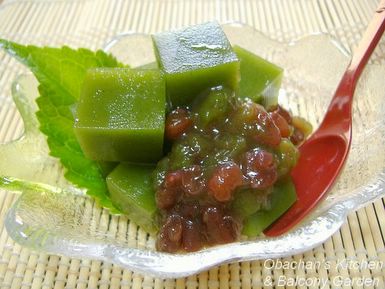 Matcha Mizu-Yokan If you are not familiar with tokoroten (agar noodles), this post tells you how we make/eat the noodles, as well as how my mom is involved in this tokoroten project (?!). OK, then, what is mizu-yokan? Here is a good explanation of what it is with a recipe and nice photo by Reid of Ono Kine Grindz. His recipe calls for kanten bars, of course. I bet any other yokan or mizu-yokan recipes call for kanten bars or kanten powder; no recipe would tell you to go to the beach and pick tengusa seaweed first. Of course not everyone lives near the beach, and the seaweed has to be dried for several weeks, but that’s not the only reason. For the better taste of kanten desserts, using kanten bars/powder is recommended over gelatin liquid just extracted from tengusa seaweed.  When we cook the seaweed to obtain the gelatin liquid, we add a little amount of vinegar. I’m not quite sure why, but they say that it probably won’t set well without the vinegar. Thus, the seaweed gelatin liquid is largely tasteless but has a slight hint of the flavor/smell of the seaweed and vinegar, which you don’t really want for your desserts. Kanten bars do not have that problem because such unwanted flavors are taken away during the repeated freezing process. That's why kanten bars are more ideal for making wagashi. When we cook the seaweed to obtain the gelatin liquid, we add a little amount of vinegar. I’m not quite sure why, but they say that it probably won’t set well without the vinegar. Thus, the seaweed gelatin liquid is largely tasteless but has a slight hint of the flavor/smell of the seaweed and vinegar, which you don’t really want for your desserts. Kanten bars do not have that problem because such unwanted flavors are taken away during the repeated freezing process. That's why kanten bars are more ideal for making wagashi.But looks like many housewives in my hometown did not care too much about such a minor(?) problem. If you cook tengusa seaweed once, you usually end up with quite a bit of gelatin liquid. If agar noodles was the only thing you can make out of it, you and your family will get tired of the noodles. Then why not go for more variety? Maybe you can hide the slight hint of the seaweed and vinegar by adding a lot of sugar and something with a strong flavor. Yeah, why not? So, in my hometown, it has been quite popular, when making agar noodles, to set aside some of the seaweed gelatin liquid and use it for making desserts like coffee-kan, umeshu-kan, nikkei cinnamon-kan and Soda-kan. For today’s experiment, I decided to go for mizu-yokan, and to give it a stronger flavor, I chose matcha mizu-yokan. Read More Now I'll show you how I made tokoroten and matcha mizu-yokan.      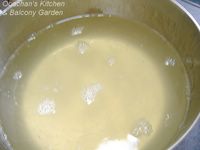 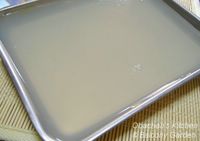 I drained it in a cloth bag, waited until it cooled a little, and while the seaweed was still warm, squeezed out the liquid as much as possible. The tengusa seaweed looked like this after squeezing (above left photo) and I got the tasteless and colorless gelatin liquid (above right photo). To make tokoroten noodles, the liquid needs to be poured in a flat container. What’s fascinating is that, unlike animal gelatin, kanten sets at room temperature and turns out very firm. But it tastes better when chilled, so I put it in the fridge after it was set. I drained it in a cloth bag, waited until it cooled a little, and while the seaweed was still warm, squeezed out the liquid as much as possible. The tengusa seaweed looked like this after squeezing (above left photo) and I got the tasteless and colorless gelatin liquid (above right photo). To make tokoroten noodles, the liquid needs to be poured in a flat container. What’s fascinating is that, unlike animal gelatin, kanten sets at room temperature and turns out very firm. But it tastes better when chilled, so I put it in the fridge after it was set.Now, from here, it gets in a real experimental phase. 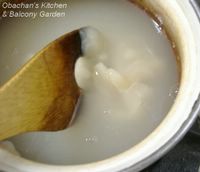 I added shiroan (sweetened white bean paste), sugar and pinch of salt to the remaining warm gelatin liquid and stirred well over low heat to dissolve them completely. In another bowl, I mixed matcha, sugar and a little hot water, then added some gelatin liquid and mixed well. The matcha mixture was then poured into the rest of the gelatin-shiroan mixture which had been removed from heat. When the whole mixture was properly flavored with matcha and colored dark green, I strained it through a sieve twice to remove tiny matcha lumps. So far, so good. I added shiroan (sweetened white bean paste), sugar and pinch of salt to the remaining warm gelatin liquid and stirred well over low heat to dissolve them completely. In another bowl, I mixed matcha, sugar and a little hot water, then added some gelatin liquid and mixed well. The matcha mixture was then poured into the rest of the gelatin-shiroan mixture which had been removed from heat. When the whole mixture was properly flavored with matcha and colored dark green, I strained it through a sieve twice to remove tiny matcha lumps. So far, so good. 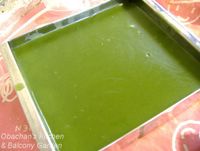 After a few hours, I sliced the mizu-yokan, and…  Ahhhhhh!!! That’s why I had to present it the way you see in the photo at the top of this post. With a hydrangea leaf, doesn’t it look somewhat like a hydrangea flower? :P Taste-wise, the matcha mizu-yokan was OK, since I couldn’t detect the taste of vinegar. But to tell you the truth, I felt a little strange aftertaste… or a slight sensation on my tongue. Maybe it was a vinegar effect? Next time I’ll try this with less vinegar and a less amount of non-mashed type of boiled azuki beans. Oh yes, there will be a next time, because I have plenty of dried tengusa seaweed left... Categories: Bloopers, Sweets |
Thursday, June 22, 2006
Matcha and Azuki Separated...
Posted by
obachan
at
6/22/2006 01:23:00 AM
![]()
Labels: Home-made wagashi
Subscribe to:
Post Comments (Atom)

















5 comments:
hi obachan, wow! fascinating post; thanks so much for sharing...i can only imagine the possibilities...
oh my, this is exactly what i need! A recipe for the dried tengusa seaweed i have at home! I bought this from Japan last december because i thought i just had to dissolve this in water to make the agar solution.
I'm so excited to try this recipe out, but my main problem: how much vinegar should i add? Could you please enlighten?... thx!
lance-s
No problem. Glad that someone found this interesting. :)
j
With your creativity, I bet you come up with millions of great ideas ;)
I guess I’d better not stick with sweets too much and look for ideas of something savory…
CG
Yeah, right. Next time I make miso soup, I might go fishing first to catch bonito and make bonito flakes myself for making dashi broth. ;P
anonymous commenter
Wow! You have dried tengusa seaweed?!
OK. The “official” recipe in my hometown says: for 60 g dried seaweed, add 14 cups (1 cup= 200 mL) water and 2 Tbsp vinegar. For this experiment, I reduced the recipe to half. And if you want to experiment with sweets, I don’t really recommend using matcha. That’s what I learned from this experiment. My guess is that a slightest hint of vinegar will remain no matter what, and something very sweet or savory may be alright with it, but the bitterness of matcha does not seem to be a good match. I’m thinking about trying something savory next time, with dashi or consommé and seafood/vegetables.
Wow, how neat! I just bought matcha and azuki yokan, and now I'm feeling like such a slacker for just going down to the store to pick some up!
anonymous commenter, again
Additional info. Mom said that she once reduced the amount of vinegar to 2/3 of what the above recipe calls for, and still it set OK. If you are going to experiment with sweets, you might want to try that.
amanda
Oh, come on, you are not a slacker. I bet the yokan you got tasted much better than mine and the matcha and azuki were not separated ;)
Post a Comment